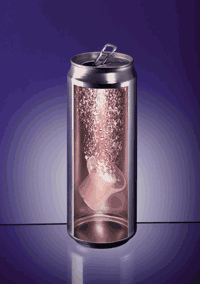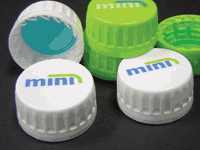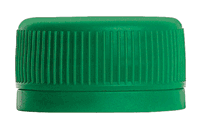February 1, 2007
|
Bottleneck, that is. Closure molders say their low-profile closures are helping beverage brand owners save big.
Materials savings remain a huge theme among closure molders, and likely will unless plastics are someday distributed for free. “The overarching theme is light-weighting. The price (of plastics) is focusing people’s minds,” says Steve White, plastics division manager at Pelliconi (Atessa, Italy), a metal closure processor that has swiftly become one of Europe’s larger plastic closure molders.
But the trick, molders say, is to combine weight savings with some added value, such as gas barrier protection or functionality, so that molders can earn their margin and brand owners get the top they want.
In November 2006 the ISBT (Intl. Society of Beverage Technologists) agreed on a new standard for a 28-mm short-neck finish, called PCO 1881 neck, which weighs 1.3g less than the standard PCO 28 neck. White notes that most carbonated soft-drink (CSD) bottles have two-piece, circa 3g closures and 5g neck rings, but he says one project has as its goal a 2.25g cap and 4g neck.
For Pelliconi’s part, the processor already has a range of lightweight (1.6g) closures for still beverages and is developing a range of one-piece closures, with an oxygen scavenger compounded into the plastic, for carbonated drinks. White’s resume includes a stint with W.R. Grace when that firm was among the first developing oxygen scavengers. “At the moment we’ve a one-piece (closure with oxygen scavenger) but the oxygen scavenging isn’t yet quite as good as our two-piece,” though it is suitable for some applications, he says.
Long at work developing low-profile closures is Bericap (Budenheim, Germany). The firm began work in 2004 on its 28-mm ‘Shorty’ low-profile closures, mostly to meet breweries’ demand for a plastic crown cork look-alike, says Corinne Goffaux, inside sales manager. Starting this spring, the molder, third–largest in the world for plastic closures, begins molding its 2.6g Shorty crown cork closures, with Martens Brewery using these on its PET-bottled beer, sold through discount grocer Aldi. Two molds for the project will run in Germany, at least initially, says Goffaux. Bericap also is ready to market 2.4g Shorty closures for CSDs. Both models are one-piece closures suitable for bottles sized to 1.5 liters; tests on larger bottles are ongoing.
Sports caps, other prototypes evolve
In 2003 Portola Tech International (Woonsocket, RI) introduced the prototype of its Fusion closure, a two-piece closure with a bayonet that depressed and pushed a powder, tablet or liquid additive into a drink as a consumer twists the closure . This can extend the life of beverages and the potency of the additives by keeping them separate until consumption.
One ongoing issue, says Piet Gruwez, sales and marketing director Europe for Portola, is that the additives suppliers do not want a closure supplier to have the ingredients for the additives, so the molder may establish small ‘hole-in-wall’ molding operations for JIT closure delivery at customers’ sites. An improved version of the Fusion, now available, includes an oxygen scavenger developed by the molder and blended into polyethylene, which is necessary since some ingredients occasionally oxidized.
Gruwez says Portola also in November launched what he claims is one of the first one-piece sports caps suitable for aseptic filling, with a dust cover sonically welded to the base cap to ensure no chance of peroxide entering the closure. Portola’s patents cover the process and the principle, he says. “The difficult part was coordinating (in a single work cell) the welding with molding of the cap and cover,” he notes.
Alcoa CSI (Indianapolis, IN) had examples of two prototypes for show at last November’s Brau beverage trade show in Nuremberg, Germany. One, called the Mini, a 28-mm closure for CSDs, weighs less than its predecessor, but more important is that its short height allows bottle blowmolders to save about 1.4g of plastic in a bottle’s neck finish, says Erica Gibson Di Meo, marketing manager. The Mini is already commercial in Central America as a two-piece closure, she says, with work on a one-piece version ongoing.
The second prototype on hand was the processor’s Sports-Max, what Gibson calls “a true one-hand opening” sports cap, even on the first opening.
Swiss closure molder Corvaglia (Eschlikon; for more, see November 2005 MPW, pg. 22) is “growing quickly,” according to Corvaglia CEO Thomas Anderegg, who says the firm is expanding programs at its Swiss and Mexican facilities so that both sites mold the firm’s full program of simple and sport-cap closures.
In development at Corvaglia is an aseptic sports cap, and the firm recently received approval from Pepsi for a one-piece, 38-mm closure for Latin America. To date, Pepsi has used a two-piece closure there.
Corvaglia also offers a ’short’ cap, which Anderegg says the firm will not patent “so that there are no worries on the part of the brandowner.” Still, he says low-profile closures’ splash in the market may not be as large as others predict. “Although everyone wants lower weight, I’m not sure they’ve all factored in the cost of a new mold and of changes to capping equipment,” he notes.
About the Author(s)
You May Also Like






